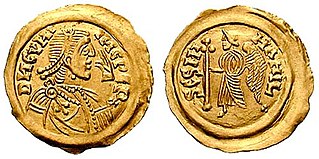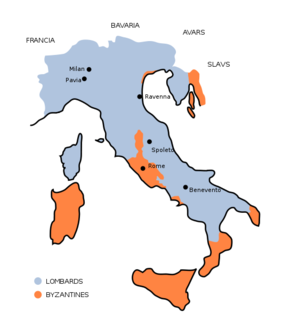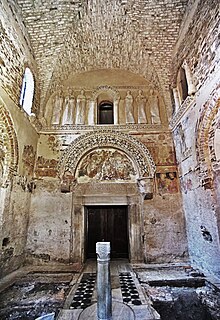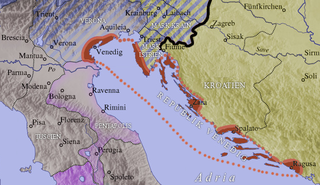Sources
| Preceded by Corvulus | Duke of Friuli c. 706 – 739 | Succeeded by Ratchis |
| | This biography of an Italian noble is a stub. You can help Wikipedia by expanding it. |
Pemmo (or Penno) was the Duke of Friuli for twenty-six years, from about 705 to his death. He was the son of Billo of Belluno.
Pemmo came to the duchy at a time when a recent civil war had ravaged the land. Pemmo raised all the children of the many nobles killed in the war in his own household next to his own sons. He also waged three wars with the Slavs of Carinthia. He defeated them so utterly the third time, that they entered into a peace treaty.
Pemmo also quarrelled with Callistus, Patriarch of Aquileia. The patriarch was at odds with the bishop of Cividale and removed him. Pemmo, in response, arrested the patriarch. For this, King Liutprand descended on Friuli and appointed Ratchis, Pemmo's son, in his place. Pemmo fled with his followers, but his son secured his pardon. Pemmo left two other sons by Ratperga: [1] Ratchait and Aistulf, who became king.
| Preceded by Corvulus | Duke of Friuli c. 706 – 739 | Succeeded by Ratchis |
| | This biography of an Italian noble is a stub. You can help Wikipedia by expanding it. |

Year 706 (DCCVI) was a common year starting on Friday of the Julian calendar. The denomination 706 for this year has been used since the early medieval period, when the Anno Domini calendar era became the prevalent method in Europe for naming years.

Year 739 (DCCXXXIX) was a common year starting on Thursday of the Julian calendar. The denomination 739 for this year has been used since the early medieval period, when the Anno Domini calendar era became the prevalent method in Europe for naming years.

Aquileia is an ancient Roman city in Italy, at the head of the Adriatic at the edge of the lagoons, about 10 kilometres (6 mi) from the sea, on the river Natiso, the course of which has changed somewhat since Roman times. Today, the city is small, but it was large and prominent in classical antiquity as one of the world's largest cities with a population of 100,000 in the 2nd century AD. and is one of the main archaeological sites of northern Italy. In late antiquity the city was the first city in the Italian Peninsula to be sacked by Attila the Hun.

Friuli is an area of Northeast Italy with its own particular cultural and historical identity containing 600,000 Friulians. It comprises the major part of the autonomous region Friuli Venezia Giulia, i.e. the administrative provinces of Udine, Pordenone, and Gorizia, excluding Trieste.

Albert I, a member of the House of Gorizia, ruled the counties of Gorizia (Görz) and Tyrol from 1258, jointly with his elder brother Meinhard IV. In 1271, the brothers divided their heritage and Albert became sole ruler of the Gorizia estates until his death. His descendants, known collectively as the Albertine line, ruled the County of Gorizia until the extinction of the House in 1500.

Cunincpert was king of the Lombards from 688 to 700. He succeeded his father Perctarit, though he was associated with the throne from 680.

The Patriarchate of Aquileia was an episcopal see in northeastern Italy, centred on the ancient city of Aquileia situated at the head of the Adriatic, on what is now the Italian seacoast. For many centuries it played an important part in history, particularly in that of the Holy See and northern Italy, and a number of church councils were held there.

Saint Paulinus II was a priest, theologian, poet, and one of the most eminent scholars of the Carolingian Renaissance. From 787 to his death, he was the Patriarch of Aquileia. He participated in a number of synods which opposed Spanish Adoptionism and promoted both reforms and the adoption of the Filioque into the Nicene Creed. In addition, Paulinus arranged for the peaceful Christianisation of the Avars and the alpine Slavs in the territory of the Aquileian patriarchate. For this, he is also known as the apostle of the Slovenes.
The dukes and margraves of Friuli were the rulers of the Duchy and March of Friuli in the Middle Ages.

Campolongo al Torre is a former comune of the Province of Udine in the Italian region Friuli-Venezia Giulia, located about 40 km northwest of Trieste and about 25 km southeast of Udine. Since 2009 it has been one of the two principal centres of Campolongo Tapogliano, a municipality formed by its merger with the former comune of Tapogliano.

The County of Gorizia, from 1365 Princely County of Gorizia, was a State of the Holy Roman Empire. Originally mediate Vogts of the Patriarchs of Aquileia, the Counts of Gorizia (Meinhardiner) ruled over several fiefs in the area of Lienz and in the Friuli region of northeastern Italy with their residence at Gorizia (Görz).

The Kingdom of the Lombards also known as the Lombard Kingdom; later the Kingdom of (all) Italy, was an early medieval state established by the Lombards, a Germanic people, on the Italian Peninsula in the latter part of the 6th century. The king was traditionally elected by the highest-ranking aristocrats, the dukes, as several attempts to establish a hereditary dynasty failed. The kingdom was subdivided into a varying number of duchies, ruled by semi-autonomous dukes, which were in turn subdivided into gastaldates at the municipal level. The capital of the kingdom and the center of its political life was Pavia in the modern northern Italian region of Lombardy.
Eric was the Duke of Friuli from 789 to his death. He was the eldest son of Gerold of Vinzgouw and by the marriage of his sister Hildegard the brother-in-law of Charlemagne.

The Duchy of Friuli was a Lombard duchy in present-day Friuli, the first to be established after the conquest of the Italian peninsula in 568. It was one of the largest domains in Langobardia Major and an important buffer between the Lombard kingdom and the Slavs, Avars, and the Byzantine Empire. The original chief city in the province was Roman Aquileia, but the Lombard capital of Friuli was Forum Julii, modern Cividale.

The Marchof Carniola was a southeastern state of the Holy Roman Empire in the High Middle Ages, the predecessor of the Duchy of Carniola. It corresponded roughly to the central Carniolan region of present-day Slovenia. At the time of its creation, the march served as a frontier defense against the Kingdoms of Hungary and Croatia.
Corvulus was the Duke of Friuli for a brief spell in the early eighth century AD. He replaced Ferdulf, but he offended King Aripert II and was arrested and his eyes gouged out. He lived in obscurity and shame as a blind exile thereafter, according to Paul the Deacon. He was ultimately replaced by Pemmo.

The March of Istria was originally a Carolingian frontier march covering the Istrian peninsula and surrounding territory conquered by Charlemagne's son Pepin of Italy in 789. After 1364, it was the name of the Istrian province of the Habsburg Monarchy, the Austrian Empire and Austria-Hungary.

The Patria del Friuli was the territory under the temporal rule of the Patriarch of Aquileia and one of the ecclesiastical states of the Holy Roman Empire. In 1420, the Republic of Venice acquired it, but it continued to be ruled for some time under its own laws and customs.

Wolfger von Erla, known in Italian as Volchero, was the Bishop of Passau from 1191 until 1204 and Patriarch of Aquileia thereafter until his death.

Cassone della Torre, also called Mosca was an Italian medieval condottiero and feudal lord. A member of the Torriani family, he was Archbishop of Milan from 1308 to 1316 and patriarch of Aquileia from 1317 to 1318.